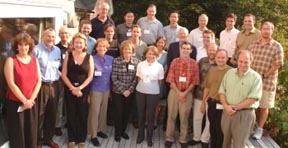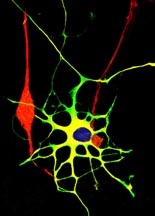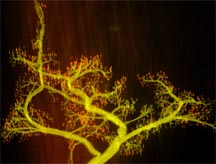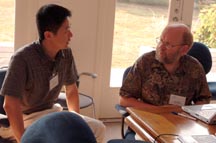
The ALSA-sponsored workshop, “Stem Cells and Axonal Regeneration: Strategies for the Treatment of ALS” held September 11-14, 2005, featured experts in stem cell biology as well as those who study the means by which nerve cells are guided to their proper targets in the developing brain and why many fail to regrow following injury. “The interactions here will bring some new collaborations to the table, with avenues that ALSA can support,” said Bruijn, who organized the workshop together with ALSA funded investigators Stephen Strittmatter, M.D., Ph.D. of Yale, an expert on the molecular controls that guide nerve growth, and stem cell biologist Clive Svendsen, Ph.D. of the Waisman Center at the University of Wisconsin in Madison.
 |
| Bottom row: Roberta Friedman, Michael Sofroniew, Marie Filbin, Christina Clark, Phyllis Brourman, Diane Winokur, Lee Martin, Ian Wilmut, Nicholas Boulis, Steve Goldman Middle row: Bob Abendroth, Tim Miller, Hynek Wichterle, Clive Svendsen, Lucie Bruijn, Michael Swash, Kevin Eggan Top row: Larry Goldstein, Yimin Zou, Doug Kerr, Su-Chun Zhang, Sam Pfaff, Stephen Strittmatter, Phillip Horner, Ben Barres Photo: Miriam Chua, Cold Spring Harbor Laboratory Public Affairs |
Discussions revealed what information is still needed to turn stem cell expertise into effective therapy. Invited speakers described the precise signals that allow developing nerve cells to find their targets and other molecular roadblocks that derail injured nerve cells trying to get back on target. The complicated array of signals that guide a growing nervous system include some that end up preventing repair in adults. Progress in restoring circuits in ALS can follow once researchers know how to recreate the proper pattern of signals.
Presenting on newly identified signals, Jeff Macklis M.D., D.HST of Harvard, Yimin Zou, Ph.D. of the University of Chicago, and Hynek Wichterle, Ph.D. of Columbia provided hope that stem cell manipulations guided by the appropriate molecular cues will improve the outlook and ultimately the quality of life for ALS patients. Wichterle showed how the patterns of signals created in a developing embryo specify the identity of each motor neuron. One can make stem cells become motor neurons of each region of the spinal cord by manipulating the signals they see. This will determine their circuits and guide them to targets. Knowing the signals is a means for making cells to test new drugs and to create possible replacement cells for disorders of the nervous system.
Macklis and colleagues have shown that the molecule called Fezl prompts motor neurons to form from stem cells in the developing brain that then travel down the spinal cord. Mice lacking the Fezl signal fail to develop these types of motor neurons, which are among those that die in ALS.
Zou and his team showed that certain proteins called Wnts are able to repel the axons of neurons as they move down from the brain towards the spinal cord, keeping descending axons corralled in their proper positions as they extend to target muscles. Knowing the role of such factors as the Wnt and Fezl proteins can help investigators understand how to effectively use stem cells to repair damage.
 |
|
This motor neuron formed from embryonic stem cells is just beginning to express one of its identifying proteins (in green); the other, red neurons, also newly formed from the stem cells, do not contain that marker. Image Credit: Douglas Kerr MD/PhD, Johns |
The glial cells called oligodendrocytes wrap around nerve fibers to provide insulation and speed conduction of impulses to muscle. But myelin contains inhibitors to regrowth. New ways to get around the normally inhibitory signals to nerve regeneration are already being exploited in animal studies. Marie Filbin, Ph.D. at Hunter College of the City University of New York has shown that some drugs available to researchers can be combined to allow new growth in mouse models of nerve injury. Filbin noted that today there are many more possible routes to encourage re-growth because we know the details of what usually stops that repair.
Indeed some repair is possible in lab models of nerve injury with relevance to ALS. As presented by Douglas Kerr M.D., Ph.D. of Johns Hopkins in Baltimore, MD., a virus can be used as a lab tool to selectively remove motor neurons in mice. Those mice with resulting motor defects can recover some function when given transplants of precursor cells together with drug therapy and trophic factor support, Kerr and colleagues have reported.
How and why nerve fibers die, and what processes are responsible in ALS, were explored by experts in so called Wallerian degeneration. This phenomenon accompanies any injury to the nerve cell’s long process, the axon, resulting in an unraveling of its myelin sheath. Molecules identified as involved in Wallerian degeneration might serve as key targets of prospective therapeutics for ALS, as described by Stanford researcher Ben Barres, M.D., Ph.D. and Jeffrey Milbrandt, M.D., Ph.D. of Washington University in St. Louis, MO. “The bottom line in ALS is that something about the axon itself is compromised,” Bruijn said. “We need to understand the dynamics of the axon as well as the cell it comes from and those that support it, how it responds to damage, and how it might regenerate.”
The process of nerve fibers dying back from muscles they innervate can now be observed in real time under the microscope, as presented by Harvard researcher Jeff Lichtman M.D., Ph.D. In mice that model ALS, other nerves attempt to take over, but cannot compensate enough, and the muscle is left without adequate input. Lichtman’s ability to see the process over an extended period in the same animal, with genetically engineered markers for each type of cell that cause them to fluoresce in different colors, undoubtedly will provide an effective new means to study ALS and test new treatments.
 |
| Nerve endings on a neck muscle in a mouse engineered to make a fluorescent protein in its motor neurons. The red dots on the muscle are the receptors that read the impulses to produce contractions. Image Credit: Bo Rum Ryu and Jeff Lichtman, M.D., Ph.D. |
Many other participants at the three day workshop also provided basics on stem cell biology and the potential for nerve repair, with new collaborations already planned. A stall in disease progression for patients with ALS might be the most realistic goal, with stem cells keeping ailing motor neurons from further deterioration. But it is also possible that functioning nerve circuits might someday be reconstituted for ALS patients who receive the cells.
Many hurdles must be overcome to ensure that stem cells can serve as tiny therapeutic dispensers to salvage dying motor neurons or even one day replace them. Svendsen and Nicholas Boulis, M.D., Ph.D. of the Cleveland Clinic presented preliminary steps towards requesting FDA permission to conduct a clinical trial of stem cell therapy to deliver trophic factors in ALS patients. The collaborators will need to do safety testing in large animals to confirm the promise of findings in rodents.
Rats with the mutation responsible for some forms of inherited ALS have received stem cells engineered to express a supportive factor called glial derived neurotrophic factor (GDNF). The results reported by Clive Svendsen show that this could be feasible for testing in patients. While Svendsen cautioned that it will be a challenge to try to treat ALS with the approach, the small animal studies did produce encouraging evidence that stem cell implants can live, make connections, and secrete GDNF as instructed.
Other trophic factors might prove even more useful, Svendsen noted. A good deal of discussion centered on which cells would be most helpful to generate by stem cell technology. Many at the workshop acknowledged that the supportive cells called glia might be even more promising to generate than nerve cells themselves. Steering the stem cells toward becoming glial cells that are also engineered to pump out restorative trophic factors could provide a treatment in ALS.
Boulis described the demanding surgery that will be required to safely enter the spinal cord and target precisely the area containing dying cells. Successful experience with targeting deep brain regions in patients with Parkinson’s disease (to deliver therapeutic electrical stimulation, not stem cells) gives encouragement that similar technology can be applied in ALS. Harvard investigator Ole Isacson, M.D., Ph.D. noted that experience with placing various types of therapeutic tissue grafts in Parkinson’s disease patients suggests that grafts survive despite the disease process present in those people’s nervous systems.
Notably, cloning expert Ian Wilmut, Ph.D., has joined the effort towards a treatment for ALS. At the workshop, Wilmut presented his plan to put the genetic instructions from ALS patient cells into embryonic stem cells in order to better understand what is going wrong in the disease. Wilmut, now at the University of Edinburgh, has obtained the license required in the U.K. to work with embryonic stem cells. He awaits funding so that he can proceed as planned to start collecting donor eggs from volunteers. The aim is to remove the genetic material from the eggs and replace it with that from ALS cells. These altered embryonic stem cells will then be prompted to become nerve cells.
 |
|
Yimin Zou and Ian Wilmut at work. Photo: Miriam Chua, Cold Spring Harbor Laboratory Public Affairs |
Wilmut and his colleagues will compare how the nerve cells develop in comparison to those from unaltered, healthy embryos. Because the altered cells would incorporate any genetic flaw responsible for the disease, changes in how they develop and function might give clues about ALS, without at first requiring a detailed knowledge of the exact genetics involved. This research won't produce therapeutic cells but should point the way to effective treatments.
Harvard researcher Kevin Eggan, Ph.D. described another possible route towards placing genetic instructions from ALS cells into fused cells derived from embryonic stem cells combined with skin cells or other cells from patients. This approach creates a cell with double the normal set of chromosomes, so it cannot yet be a treatment but might, as with Wilmut’s work, lead to new ways to test potential therapies.
ALSA trustee Bob Abendroth extended ALSA’s appreciation to the workshop participants, noting that “research from people like you is going to solve this horrible disease.”
Related Links:
- Agenda for Stem Cell Workshop (requires Adobe Acrobat Reader)
- Stem cell journal news summary
Additional Information on stem cells on the ALSA web site:
Clive Svendsen and stem cells making GDNF
Stem Cell Trial Proposal for ALS
Publications by:
